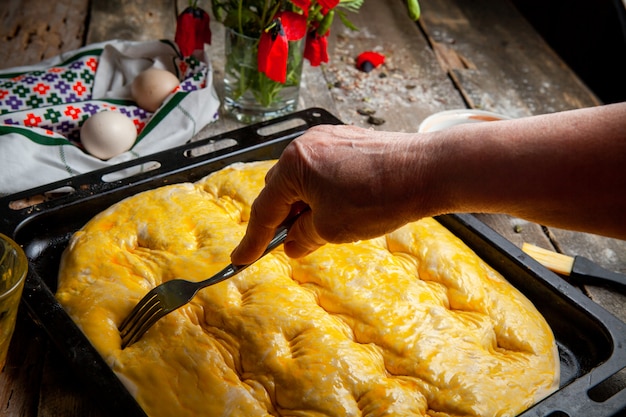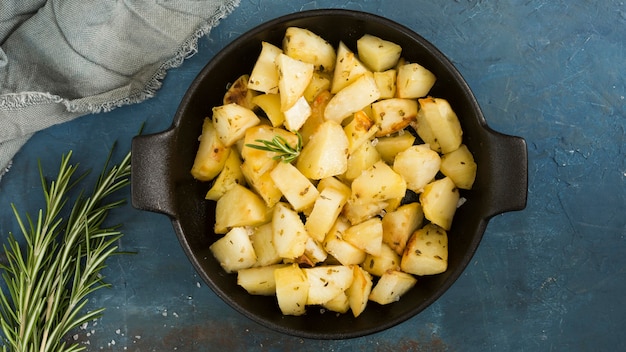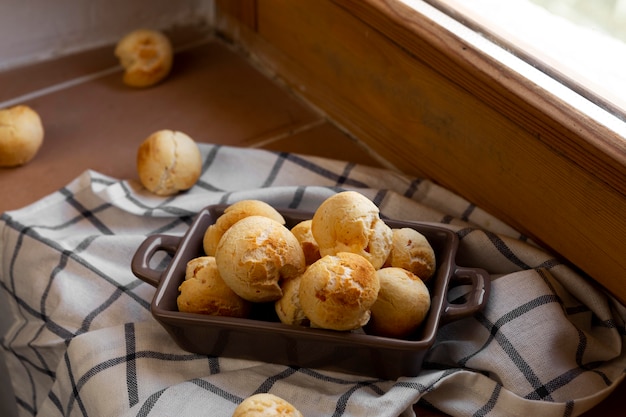Ah, potatoes. They're the ultimate comfort food, aren't they? From those crispy roast potatoes that steal the show at a Sunday roast to the creamy, comforting mashed potatoes that make any meal feel complete, there's something about potatoes that just warms the soul. Over the years, I've baked my fair share of potatoes, and let me tell you, I've learned a thing or two about getting them perfectly cooked. This isn't just any guide, this is the ultimate guide, packed with tips, tricks, and all the secrets I've picked up along the way. So grab your favourite spuds and let's get baking!
(Part 1) Choosing Your Potatoes: It's Not Just Any Spud

The first step to baking perfect potatoes? Choosing the right ones! Now, you might think, "It's just a potato, what difference can it make?" But trust me, it's a big deal. Different varieties have different properties that influence how they cook, so choosing wisely is crucial.
The maris piper: My Go-To for Roasting
My personal favourite for roasting is the Maris Piper. They're firm and starchy, which means they'll hold their shape beautifully in the oven, getting gloriously crispy on the outside and fluffy on the inside. They're a true star for roasts and hold up well when mashed, too.
king edward: The Sweet and Delicate Option
If you want something a bit sweeter and more delicate, the King Edward is your guy. These beauties are softer than the Maris Piper, making them ideal for baking whole, especially if you want a tender texture. They're also brilliant for mashed potatoes, giving you a smooth, creamy result.
Desiree: The Versatile Performer
Then there's the Desiree, a versatile potato with a slightly waxy texture. They cook evenly and hold their shape well, making them a great choice for salads or gratins. They're a bit less starchy, which means they won't get as crispy as a Maris Piper, but they have their own charm.
(Part 2) Preparing Your Potatoes: Getting Them Ready for the Oven

You've got your potatoes, now it's time to get them prepped for the oven. This might seem simple, but a few key steps make a big difference in the final result.
Washing, Scrubbing, and Peeling: The First Steps
First, give those potatoes a good wash. No one wants a muddy spud in their dinner! Next, you need to decide whether to peel them or not. For roasting, I usually leave the skins on. It adds a bit of extra flavour and texture, and it's a little less work. But if you're making mashed potatoes, peeling is often the way to go.
The Art of Cutting: Size Matters
If you're roasting, cutting your potatoes into even-sized pieces ensures they cook evenly. I like to cut them into wedges, but you can chop them into cubes, slices, or even leave them whole. It depends on your preference and the dish.
The Salting Trick: A Secret Weapon
One of my secret weapons for crispy potatoes is salting them before cooking. Salt helps to draw out the moisture, which results in those perfect, crispy edges we all crave. Don't be afraid to be generous with the salt; it makes a big difference.
(Part 3) The Essential Roasting Technique: A Simple Guide to Perfection

Now we're getting to the heart of the matter: roasting those potatoes to perfection. This is where the real magic happens.
The Perfect Oven Temperature: A Hot Start
Start by preheating your oven to 200°C (400°F). This is the sweet spot for roasting potatoes, giving you a crispy exterior and fluffy interior.
The Oil Factor: A Key to Crispiness
Here's a trick I learned from my grandmother: Toss those potatoes in some oil before roasting. I use a good quality olive oil, but sunflower oil or rapeseed oil work well too. Make sure they're well coated, but not swimming in oil. The goal is a light coating to help them crisp up.
Spacing is Key: Give Them Room to Breathe
When you put your potatoes in the oven, give them some space. Don't overcrowd the baking tray. This allows the hot air to circulate around them, ensuring they cook evenly and develop those gorgeous golden brown edges.
The Flipping Technique: For Even Browning
About halfway through the cooking time, give those potatoes a good toss or flip them over. This helps them brown on all sides and prevents them from sticking to the tray. It also ensures that every potato gets its chance in the limelight.
The Timing Game: It Depends on the Potato
roasting time varies depending on the size and type of potato. I find it takes about 30-40 minutes for wedges, but check them regularly. They're done when they're golden brown and crisp. Use a fork to check if they're cooked through.
(Part 4) Mastering the Roast Potatoes: Tips for Taking Them to the Next Level
Roasting potatoes, you can't really go wrong, but there's always room for improvement. Here are a few tricks to take your roast potatoes from good to absolutely incredible.
The Rosemary and Garlic Trick: A Classic Combination
One of my favourite ways to elevate roast potatoes is with rosemary and garlic. Simply add a few sprigs of rosemary and a couple of crushed garlic cloves to the baking tray. The aroma will infuse the potatoes as they cook, creating a fragrant and flavourful dish.
The Herb and Spice Boost: Experiment with Flavours
Feel free to experiment with other herbs and spices. I've tried everything from thyme and oregano to paprika and cumin. A bit of chilli flakes can add a nice kick too. Let your imagination run wild!
The Lemon Squeeze: A Touch of Tanginess
For a tangy twist, try squeezing some lemon juice over your potatoes just before serving. It cuts through the richness of the oil and adds a bright flavour. It's a simple trick that makes a big difference.
The Butter Finish: A Touch of Richness
Right before serving, toss those potatoes with a knob of butter. It'll add a silky smoothness and a rich, buttery flavour. It's the perfect finishing touch for a truly indulgent potato experience.
(Part 5) baking potatoes Whole: A Comforting Classic
Whole baked potatoes are a comforting classic, perfect for a simple meal or as a side dish. They're incredibly versatile and can be topped with all sorts of delicious things.
The Prick and Bake Method: Preventing Explosions
For the best results, prick the potatoes all over with a fork. This allows the steam to escape, preventing them from exploding in the oven. Bake them at 200°C (400°F) for about 1 hour, or until they're tender when pierced with a fork.
The Foil Wrap Trick: For a Softer Texture
Another method is to wrap the potatoes in foil before baking. This helps to steam them, creating a softer and fluffier texture. Bake them at 200°C (400°F) for about 1 hour, then unwrap them for the last 10-15 minutes to allow them to crisp up.
The Topping Options: Endless Possibilities
Once your potatoes are cooked, the fun really begins. There are endless topping options. I love a simple dollop of butter and a sprinkle of salt and pepper, but you can get creative with cheese, sour cream, salsa, or even chili. It's all about finding what you love.
(Part 6) Mashed Potato Perfection: Avoiding Lumps and Dryness
Mashed potatoes are a comforting classic, but they can be a bit tricky to get right. Here's how to avoid lumpy, dry mashed potatoes and create a creamy, dreamy side dish.
The Boiling Method: The Foundation for Great Mash
First, you need to boil your potatoes. I prefer to boil them until they're fork-tender, but not mushy. The goal is to cook them through without making them fall apart.
The Draining Technique: Don't Rinse Away the Starch
Once they're cooked, drain them in a colander, but don't rinse them. The starch on the potatoes is essential for creating creamy mashed potatoes. It helps to bind everything together.
The Mashing Method: Achieve a Smooth Texture
Now comes the mashing part. I use a potato masher, but you can also use a fork or a food mill. The key is to mash them until they're smooth and creamy, but not over-mashed. You want a velvety texture, not a paste.
The Milk and Butter Addition: Enhancing Flavor and Texture
While the potatoes are still hot, add some warm milk and butter. This will give them a smooth, silky texture and add a delicious flavour. The warmth of the milk and butter also helps to prevent the potatoes from becoming lumpy.
The Seasoning Touch: Adding Depth of Flavor
Finally, season your mashed potatoes to taste with salt, pepper, and a touch of nutmeg for an extra touch of warmth. A little bit of garlic powder or onion powder can also add a delicious depth of flavour.
(Part 7) Going Beyond the Basics: Exploring the World of Potato Dishes
So far, we've covered the classics, but let's get a bit more adventurous. There's a whole world of potato dishes beyond roasted and mashed. Let's explore some other ways to use potatoes to create delicious meals.
potato gratins: Layers of Flavor and Comfort
Potato gratins are a beautiful and decadent dish. They're basically layers of thinly sliced potatoes, cheese, and cream, baked until golden brown and bubbly. They're perfect for a special occasion or a comforting weeknight meal.
potato salads: A Versatile Side Dish
Potato salads are a great way to use up leftover cooked potatoes. You can get creative with your ingredients, adding everything from mayonnaise and mustard to herbs and vegetables. There's no limit to the flavor combinations you can create.
potato soups: Hearty and Comforting
Potato soups are a comforting and satisfying dish, perfect for a chilly day. You can make them creamy and hearty or light and refreshing, depending on your preference. They're easy to make and can be customized to your liking.
potato fritters: Crispy and Delicious
Potato fritters are a delicious and crispy snack or appetizer. Simply grate potatoes, mix them with flour and spices, then fry them until golden brown and crispy. They're a great way to use up leftover potatoes and are always a crowd-pleaser.
(Part 8) FAQ: Your Potato Baking Questions Answered
Alright, I know you might have some questions, so let's address them head-on.
1. How do I know if my potatoes are cooked?
The best way to tell if your potatoes are cooked is to pierce them with a fork. They should be tender and easily pierced. If you encounter resistance, they need a little more time in the oven.
2. What if my potatoes are too crispy?
If your potatoes are too crispy, they might be overcooked. Next time, try reducing the oven temperature or shortening the cooking time. It's all about finding the sweet spot for your oven and your potatoes.
3. Can I use frozen potatoes for roasting?
You can definitely use frozen potatoes for roasting. Just make sure to thaw them completely before roasting. Frozen potatoes tend to have a higher moisture content, so they might need a bit longer in the oven.
4. How do I keep my potatoes from sticking to the baking tray?
To prevent sticking, make sure your baking tray is well-greased. You can also line the tray with parchment paper. This will make cleanup a breeze, too.
5. What are some other ways to cook potatoes?
Besides baking, you can cook potatoes in a variety of other ways, including boiling, frying, microwaving, and steaming. Experiment and find your favourite methods. Each cooking method produces a different texture and flavour, so explore the possibilities.
So there you have it, my ultimate guide to baking perfect potatoes in the oven. From choosing the right spud to mastering the art of roasting, I've shared all my secrets with you. Now it's your turn to experiment, get creative, and bake those perfect potatoes. Happy cooking!
Everyone is watching

Corn on the Cob: The Ultimate Guide to Perfectly Cooked Ears
Healthy MealsAh, corn on the cob. Just the name evokes images of sunny days, barbecues, and that sweet, juicy flavour that ...

Perfect Pork Roast Oven Cooking Time: A Guide to Delicious Results
Healthy MealsThere's something truly satisfying about a perfectly roasted pork. The aroma alone is enough to make your mout...

Ham Cooking Time: How Long to Bake, Smoke, or Boil a Delicious Ham
Healthy MealsAh, ham. It's a classic, isn't it? A real crowd-pleaser, especially around holidays. And when done right, it'...

Scallops: The Ultimate Guide to Perfect Cooking
Healthy MealsAh, scallops. Those delicate, sweet, and utterly delicious morsels of the sea. They hold a special place in my...

Spaghetti Squash: The Ultimate Guide to Cooking and Serving
Healthy MealsRemember that time you saw spaghetti squash at the supermarket, looking all bumpy and strange, and thought, "W...
